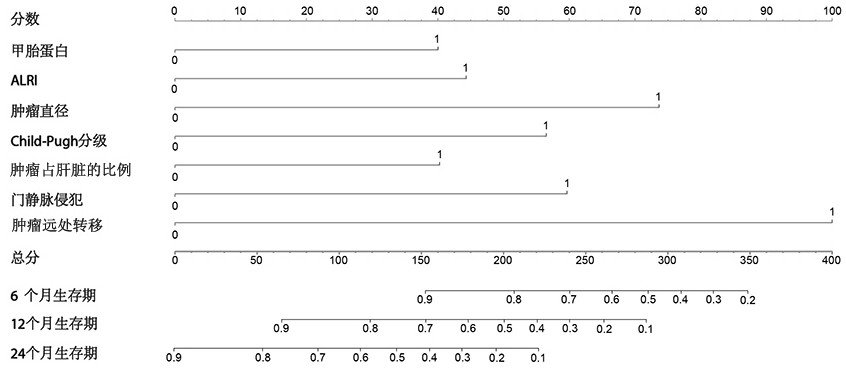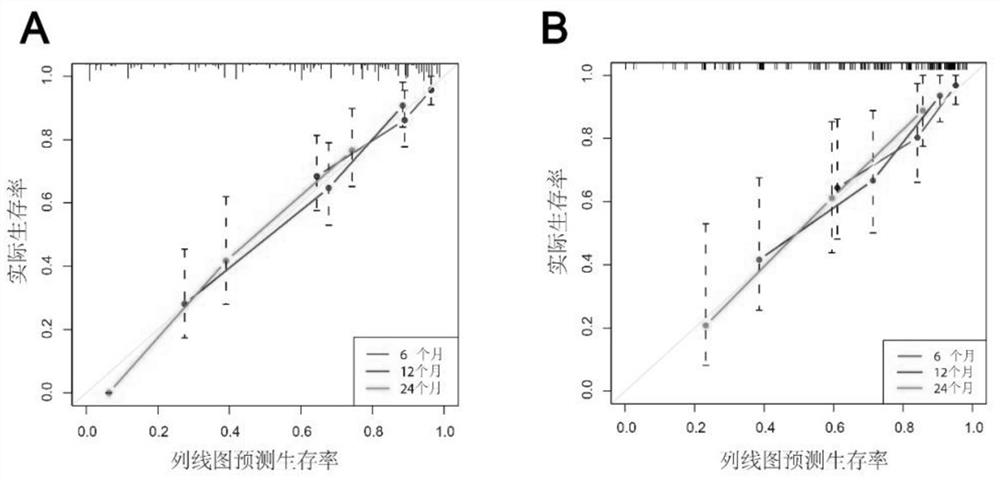A kit for predicting the prognosis of liver cancer treated with drug-loaded microsphere chemoembolization
A post-treatment, drug-loading technology, which is applied in the field of medicine and biology, can solve problems such as the failure to establish a nomogram model for prognosis prediction, and achieve the effect of small difference between the predicted value and the actual value and high consistency
- Summary
- Abstract
- Description
- Claims
- Application Information
AI Technical Summary
Problems solved by technology
Method used
Image
Examples
Embodiment 1
[0089] Embodiment 1: sample collection and sample processing
[0090] (1) A total of 302 HCC patients who were unwilling or unable to undergo surgical resection in the First Affiliated Hospital of Zhengzhou University from June 2016 to May 2020 received DEB-TACE as initial treatment were included. Inclusion criteria were: 1) age > 18 years; 2) liver function Child-Pugh A or B grade; 3) Eastern Cooperative Oncology Group (ECOG) score 0-2 points; HCC that is willing or unresectable and has at least one measurable lesion; 5) has not received other treatments such as surgery, cTACE, ablation or targeted drugs; 6) DEB-TACE is the initial treatment. Exclusion criteria: 1) Child-Pugh C grade of liver function; 2) ECOG score 3-4 points; 3) invasion of hepatic vein or inferior vena cava; 4) complete obstruction of main portal vein; 5) suffering from other malignant tumors; 6) Incomplete clinical or follow-up data; 7) Severe heart, liver and kidney dysfunction, abnormal coagulation fun...
Embodiment 2
[0097] Example 2: Screening of independent factors associated with survival after DEB-TACE in patients with liver cancer
[0098] (1) Univariate Cox regression analysis was used to analyze the clinical factors that may be related to the survival of patients with liver cancer after DEB-TACE:
[0099] In the modeling group, SPSS 21.0 statistical software was used to conduct univariate Cox regression analysis on the clinical factors that may be related to the survival of patients with liver cancer after DEB-TACE, and to evaluate the prognostic value of clinical factors on the survival of patients with liver cancer after DEB-TACE . Through single factor Cox regression analysis, it was found that aspartate aminotransferase, glutamyl transpeptidase, alkaline phosphatase, alpha-fetoprotein expression, bilirubin, ascites, tumor diameter, tumor number, proportion of tumor to liver, presence or absence Tumor capsule, presence or absence of portal vein invasion, presence or absence of d...
Embodiment 3
[0110] Example 3: Establishment of a survival prediction model for patients with liver cancer after DEB-TACE
[0111] The independent prognostic factors related to the survival of patients with liver cancer after DEB-TACE obtained by multivariate Cox regression analysis were assigned, and the assigned values are shown in Table 3.
[0112] Table 3 Assignment of independent prognostic factors related to survival after DEB-TACE in patients with liver cancer
[0113] variable assignment distant metastasis With distant metastasis = 1, without distant metastasis = 0 ALRI ≤40=0,>40=1 Child-Pugh classification A=0, B=1 tumor diameter ≤5cm=0, >5cm=1 tumor to liver ratio ≤1 / 2=0,>1 / 2=1 portal vein invasion no=0, yes=1 Alpha-fetoprotein expression ≤400ng / mL=0, >400ng / mL=1
[0114]According to the results of multivariate Cox regression analysis, the risk function expression of each factor was established with the β value of t...
PUM
| Property | Measurement | Unit |
|---|---|---|
| diameter | aaaaa | aaaaa |
Abstract
Description
Claims
Application Information
 Login to View More
Login to View More - R&D
- Intellectual Property
- Life Sciences
- Materials
- Tech Scout
- Unparalleled Data Quality
- Higher Quality Content
- 60% Fewer Hallucinations
Browse by: Latest US Patents, China's latest patents, Technical Efficacy Thesaurus, Application Domain, Technology Topic, Popular Technical Reports.
© 2025 PatSnap. All rights reserved.Legal|Privacy policy|Modern Slavery Act Transparency Statement|Sitemap|About US| Contact US: help@patsnap.com



